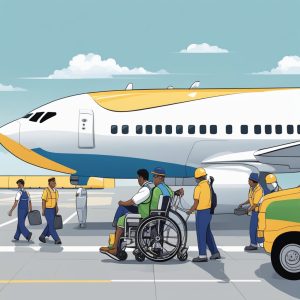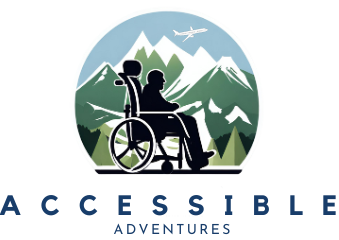Can You Stay in Your Wheelchair on a Plane? A Guide for Passengers with Disabilities

If you are a wheelchair user, you may be wondering if you can stay in your wheelchair on a plane. The answer is no, but there are accommodations available to make air travel accessible for individuals with disabilities.
Pre-flight preparations are key to ensuring a smooth travel experience.
It is recommended that you contact your airline in advance to request any necessary accommodations, such as wheelchair assistance, accessible seating, or additional legroom.
You should also pack any necessary medical supplies and medications in your carry-on bag, as well as any mobility aids such as a cane or walker.
Arriving early to the airport will give you time to navigate security and boarding procedures at a comfortable pace.
Key Takeaways
- Wheelchair users cannot stay in their wheelchair on a plane, but accommodations are available to make air travel accessible.
- Pre-flight preparations such as contacting the airline in advance and packing necessary medical supplies are important for a smooth travel experience.
- Airport and security procedures, onboard accessibility, and arrival and post-flight processes should be researched in advance to ensure a comfortable and enjoyable trip.
Pre-Flight Preparations
Booking and Airline Policies
When booking your flight, it is important to inform the airline that you will be traveling with a wheelchair. This will allow them to make the necessary arrangements and ensure that your needs are met.
Each airline has its own policies regarding wheelchair travel, so it is important to check with them beforehand. You can find this information on their website or by calling their customer service line.
Under the Air Carrier Access Act, airlines are required to provide wheelchair storage in the cabin for collapsible, folding, or break-down manual wheelchairs. For powered wheelchairs, airlines are required to transport them as checked baggage.
However, some airlines may have additional policies or restrictions regarding powered wheelchairs.
Preparing Your Wheelchair for Flight
Preparing your wheelchair for flight can help prevent damage during transport. Here are some tips to help you prepare:
- Remove any loose or detachable parts, such as the joystick or cushion, and pack them in a separate bag.
- If your wheelchair has a lithium-ion battery, make sure it is properly labeled and packaged according to airline regulations. You may need to disconnect the battery and tape the terminals to prevent accidental activation.
- If your wheelchair is collapsible or foldable, make sure it is secured with straps or ties to prevent it from unfolding during transport.
- Wrap your wheelchair in bubble wrap or plastic bags to protect it from scratches and other damage.
- Finally, make sure to label your wheelchair with your name, contact information, and flight details.
Airport and Security Procedures
When you are traveling by plane and require a wheelchair, you might wonder what to expect at the airport and during the security screening process. Here is what you need to know about airport and security procedures.
Check-In and Security Screening
When you arrive at the airport, make sure to check in with the airline and request wheelchair assistance if you have not done so already.
You can also request pre-boarding to avoid the crowds and board the plane before other passengers.
At the security checkpoint, you can remain in your wheelchair for most of the screening process. If you are unable to walk through the metal detector, you will receive a pat-down screening.
You can request a manual pat-down at airport screening if you cannot walk through the detectors. And you can request a same-sex screener to perform the manual pat-down.
You may also inform the TSA officer of your disability or medical condition verbally, by using the TSA Notification Card, or by providing medical documentation.
Boarding and Pre-Boarding
When it is time to board the plane, you can board the airplane before other passengers.
If you self-identify as a passenger with a disability who needs additional time or assistance to board the airplane, the airline must allow you to board the airplane before other passengers.
If you have a gate-checked wheelchair, the airline will provide you with an aisle chair to help you get to your seat.
Onboard Accessibility
If you are a wheelchair user, you may be wondering about the accessibility options available to you on board a plane. In this section, we will discuss the different aspects of onboard accessibility and what you can expect.
Wheelchair Storage and Cabin Accessibility
Most airlines allow you to bring your wheelchair on board the plane, but it will need to be stowed during the flight.
If your wheelchair is collapsible, it can be stored in the overhead bin or in a closet near your seat. If your wheelchair is non-collapsible, it will be stored in the cargo hold.
When it comes to cabin accessibility, most planes have an aisle chair that can be used to transfer you from your wheelchair to your seat. The aisle chair is a narrow wheelchair that can fit down the aisle of the plane.
Once you are in your seat, you can store your wheelchair and any other carry-on luggage in the overhead bin or under the seat in front of you.
In-Flight Services and Assistance
During the flight, flight attendants are available to assist you with any needs you may have.
They can help you with tasks such as using the lavatories or getting to your seat. Some planes also have footrests that can be used to elevate your legs during the flight.
If you require catheters or other medical equipment, you are allowed to bring them on board the plane.
It is recommended that you inform the airline of any medical needs prior to the flight so that they can make any necessary arrangements.
Arrival and Post-Flight Process
Once the plane has landed, the flight attendants will announce the arrival and ask all passengers to remain seated until the plane has come to a complete stop.
If you are a wheelchair user, you will be allowed to remain in your wheelchair until all other passengers have deplaned. This is to ensure your safety and comfort while deplaning.
Deplaning and Wheelchair Retrieval
After all other passengers have deplaned, the flight attendants will assist you in deplaning.
If you have a travel companion, they can also assist you in deplaning.
You will be transferred to a transfer sling, which will help you move from your seat to your wheelchair.
The airline staff will then retrieve your wheelchair from the cargo hold and bring it to the gate. Once your wheelchair is available, the airline staff will help you transfer back to your wheelchair.
Connecting Flights and Airport Navigation
If you have a connecting flight, the airline staff will assist you in navigating the airport.
They will provide you with a transfer wheelchair and help you get to your next gate.
If you need assistance with baggage claim, the airline staff will provide you with a transfer wheelchair and help you get to the baggage claim area.
If you encounter any issues during your travel, such as lost or damaged equipment, you should file a complaint with the airline.
The airline staff will provide you with the necessary forms to file a complaint.
Frequently Asked Questions
How do airlines accommodate passengers who use wheelchairs?
Airlines are required to accommodate passengers who use wheelchairs under the Air Carrier Access Act (ACAA).
The ACAA requires airlines to provide assistance to passengers with disabilities, including passengers who use wheelchairs, throughout their air travel experience. This assistance includes boarding and deplaning, transferring to and from seats, and stowing and retrieving mobility aids.
Are there any additional fees for transporting wheelchairs on airplanes?
Airlines are not allowed to charge additional fees for transporting wheelchairs on airplanes.
The ACAA prohibits airlines from charging passengers with disabilities for services that are necessary to accommodate their disabilities.
However, airlines may require advance notice of a passenger’s need for a wheelchair or other mobility aid in order to ensure that the necessary equipment and personnel are available.
What is the process for boarding and deplaning for wheelchair users?
Passengers who use wheelchairs can board and deplane the aircraft in a number of ways, depending on their individual needs.
Some passengers may be able to walk onto the aircraft and transfer to an aircraft seat, while others may require a lift or other assistance to board the aircraft.
Similarly, some passengers may be able to walk off the aircraft and transfer to a wheelchair or other mobility aid, while others may require a lift or other assistance to deplane the aircraft.
How is a personal wheelchair stored during a flight?
Personal wheelchairs are typically stored in the cargo hold of the aircraft during a flight.
Airlines are required to take steps to ensure that personal wheelchairs are not damaged during transport, and passengers should be aware that they may need to sign a waiver of liability before the airline will transport their wheelchair.
What are the seating arrangements for passengers who remain in their wheelchairs?
Passengers who remain in their wheelchairs during a flight are typically seated in specially designed seats that are secured to the aircraft floor.
These seats are designed to provide maximum comfort and safety for passengers who remain in their wheelchairs during a flight.
Do wheelchair users have priority boarding or deplaning on commercial flights?
The ACAA requires airlines to provide priority boarding and deplaning to passengers with disabilities, including passengers who use wheelchairs.
However, the specific procedures for priority boarding and deplaning may vary depending on the airline and the individual passenger’s needs.
Passengers who require priority boarding or deplaning should contact their airline in advance to arrange for this service.
